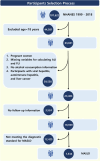Association of advanced lung cancer inflammation index with all-cause and cardiovascular mortality in metabolic dysfunction associated steatotic liver disease
- PMID: 40301487
- PMCID: PMC12041350
- DOI: 10.1038/s41598-025-99311-2
Association of advanced lung cancer inflammation index with all-cause and cardiovascular mortality in metabolic dysfunction associated steatotic liver disease
Abstract
Metabolic dysfunction-associated steatotic liver disease (MASLD), formerly known as non-alcoholic fatty liver disease (NAFLD), is a growing global health concern due to its rising prevalence and association with hepatic and cardiovascular diseases. This study aimed to assess the prognostic value of the Advanced Lung Cancer Inflammation Index (ALI)-a combined indicator of nutritional and inflammatory status-in predicting all-cause and cardiovascular mortality in MASLD patients.Data were drawn from MASLD-diagnosed adults (≥ 18 years) in the National Health and Nutrition Examination Survey (NHANES) from 1999 to 2018, with mortality tracked until December 31, 2019. ALI was calculated for each participant, and its relationship with long-term mortality was analyzed using multivariable Cox regression, restricted cubic spline (RCS) regression, and subgroup analyses. Additionally, the mediating role of biological age, including Klemera-Doubal method biological age (KDM BA) and homeostatic model assessment (HD), was assessed in this relationship through mediation analysis. Among 7,534 MASLD patients, higher ALI quintiles were significantly associated with reduced all-cause (aHR = 0.591, P = 0.004) and cardiovascular mortality (aHR = 0.393, P = 0.026). A nonlinear relationship was observed between ALI and mortality outcomes (P < 0.001). Subgroup analysis indicated ALI's stronger predictive value in older adults (≥ 60), females, and lifelong non-smokers. Mediation analysis showed that KDM BA and HD partially mediated the ALI-mortality relationship (34.02% and 37.87% for all-cause mortality; 37.60% and 58.69% for cardiovascular mortality, respectively). Higher values of the ALI are associated with reduced all-cause and cardiovascular mortality in patients with MASLD, with biological age serving as a partial mediator. Improved nutritional and inflammatory status enhances the prognosis of MASLD patients.
Keywords: Advanced lung cancer inflammation index (ALI); All-cause mortality; Biological age; Cardiovascular mortality; Inflammation; Metabolic dysfunction associated steatotic liver disease (MASLD); Nutrition.
© 2025. The Author(s).
Conflict of interest statement
Declarations. Competing interests: The authors declare no competing interests. Ethics approval and consent to participate: The study’s ethical framework received approval from the Ethics Review Board at the National Center for Health Statistics (NCHS). All participants have been provided informed consent.
Figures





Similar articles
-
The role of the advanced lung cancer inflammation index (ALI) in the risk of liver fibrosis and mortality among US adult MAFLD patients: a cross-sectional study of NHANES 1999-2018.BMC Gastroenterol. 2025 Mar 20;25(1):190. doi: 10.1186/s12876-025-03762-w. BMC Gastroenterol. 2025. PMID: 40114055 Free PMC article.
-
Association between triglyceride-glucose related indices and mortality among individuals with non-alcoholic fatty liver disease or metabolic dysfunction-associated steatotic liver disease.Cardiovasc Diabetol. 2024 Jul 4;23(1):232. doi: 10.1186/s12933-024-02343-7. Cardiovasc Diabetol. 2024. PMID: 38965572 Free PMC article.
-
Prognostic effect of triglyceride glucose-related parameters on all-cause and cardiovascular mortality in the United States adults with metabolic dysfunction-associated steatotic liver disease.Cardiovasc Diabetol. 2024 Jun 1;23(1):188. doi: 10.1186/s12933-024-02287-y. Cardiovasc Diabetol. 2024. PMID: 38824550 Free PMC article.
-
Systemic impacts of metabolic dysfunction-associated steatotic liver disease (MASLD) and metabolic dysfunction-associated steatohepatitis (MASH) on heart, muscle, and kidney related diseases.Front Cell Dev Biol. 2024 Jul 16;12:1433857. doi: 10.3389/fcell.2024.1433857. eCollection 2024. Front Cell Dev Biol. 2024. PMID: 39086662 Free PMC article. Review.
-
Management of Metabolic-Associated Fatty Liver Disease/Metabolic Dysfunction-Associated Steatotic Liver Disease: From Medication Therapy to Nutritional Interventions.Nutrients. 2024 Jul 11;16(14):2220. doi: 10.3390/nu16142220. Nutrients. 2024. PMID: 39064665 Free PMC article. Review.
References
-
- Rinella, M. E. et al. A multisociety Delphi consensus statement on new fatty liver disease nomenclature. J. Hepatol.79(6), 1542–1556 (2023). - PubMed
-
- Luo, N., Zhang, X., Huang, J., Chen, H. & Tang, H. Prevalence of steatotic liver disease and associated fibrosis in the United States: Results from NHANES 2017-March 2020. J. Hepatol.80(2), e70–e71 (2024). - PubMed
-
- Pan, Z., Shiha, G., Esmat, G., Méndez-Sánchez, N. & Eslam, M. MAFLD predicts cardiovascular disease risk better than MASLD. Liver Int. Official J. Int. Assoc. Study Liver10.1111/liv.15931 (2024). - PubMed
MeSH terms
Grants and funding
LinkOut - more resources
Full Text Sources
Medical

